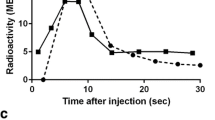Abstract
Accurate description of the arterial time-activity curve (ATAC) is of paramount importance in quantitative determination of the regional cerebral blood flow (rCBF) using positron tomography following bolus i.v. injection of O-15 labeled water. Frequent manual sampling from an arterial catheter does not permit sampling in less than 5-sec intervals and runs the risk of missing the arrival time or the peak count. A continuous ATAC monitoring system has been developed. This system consists of a single bismuth germanate detector in a lead shield and a constant-flow aspirator. The arterial blood was drawn continuously from a catheter within the brachial artery into an extended tube and its activity was monitored by the detector as the detector time-activity curve (DTAC). Comparison with the manual sampling from the contralateral brachial artery in the same run revealed that the DTAC differed from the manual sampling not only in delayed arrival but also in the shape of the curve, which was dispersed because of viscosity and the width of the detector field of view. However, deconvolution of DTAC using the experimentally obtained system step response provided an accurate arterial time course, which successfully filled in the gaps of the manual sampling. Moreover, water and blood showed different dispersion in the step response, suggesting that the system function should be determined using blood or a fluid of similar hydrodynamic nature.
Similar content being viewed by others
References
Herscovitch P, Markham J, Raichle ME: Brain blood flow measured with intravenous H2 15O. I. Theory and error analysis.J Nucl Med 24: 782–789, 1983
Raichle ME, Martin WR, Herscovitch P, et al: Brain blood flow measured with intravenous H2 15O. II. Implementation and validation.J Nucl Med 24: 790–798, 1983
Herscovitch P, Raichle ME: Effect of tissue heterogeneity on the measurement of cerebral blood flow with equilibrium C15O2 inhalation technique.J Cereb Blood Flow Metabol 3: 407–415, 1983
Gamel J, Rousseau WF, Katholi CR, et al: Pitfalls in digital computation of the impulse response of vascular beds from indicator-dilution curves.Circ Res 32: 516–523, 1973
Hutchins GD, Hichwa RD, Koeppe RA: A continuous flow input function detector for H2 15O blood flow studies in positron emission tomography.IEEE Trans Nucl Sci 33: 546–549, 1986
Chien S, Vsami S, Taylor HM, et al: Effects of hematocrit and plasma proteins on human blood rheology at lower shear rates.J Appl Physiol 21: 81–87, 1966
Iida H, Kanno I, Miura S, et al: Error analysis of a quantitative cerebral blood flow measurement using H2 15O autoradiography and position emission tomography, with respect to the dispersion of the input function.J Cereb Blood Flow Metabol 6: 536–545, 1986
Senda M, Nishizawa S, Shibata T, et al: Effect of arterial blood dispersion on the measurement of cerebral blood flow using PET and O-15 water.J Nucl Med 28: 656, 1987, (abstr)
Author information
Authors and Affiliations
Rights and permissions
About this article
Cite this article
Senda, M., Nishizawa, S., Yonekura, Y. et al. Measurement of arterial time-activity curve by monitoring continuously drawn arterial blood with an external detector: Errors and corrections. Ann Nucl Med 2, 7–12 (1988). https://doi.org/10.1007/BF03164580
Received:
Accepted:
Issue Date:
DOI: https://doi.org/10.1007/BF03164580




